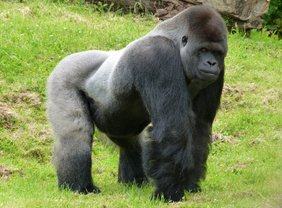Ranges of Western Lowland Gorillas
Categories: Journal, Ausgabe 68, Gorilla Groups, Ecology, Behaviour, Other countries, Other protected areas, Western Lowland Gorilla
Western lowland gorilla ranges are in general larger than those of mountain gorillas - this has been the general opinion among researchers for a long time. This was attributed to ecological differences in resource availability and diet, with more frugivorous species having larger home ranges than folivorous species, since fruit trees tend to be more spread out in space (location) and time (seasonal fruiting).
The results of a new 8-year study in the Ndoki Forest, Republic of Congo, suggest a different picture. The team collected data for five habituated groups of gorillas. Two of these groups were from the Goualougo Triangle and three from Mondika: Loya (3-6 individuals during the study period), Makassa (2-3 individuals), Kingo (5-13 individuals), Buka (5-11 individuals) and Mététélé (11-15 individuals).
The average annual home range size was 5.39 km² and the average core area was 1.54 km². Home ranges overlapped with those of other groups for all five groups on average with 78 %. For core areas, the overlap was on average 72 %. In mountain gorillas, average overlaps were 82 % for home ranges and 76 % for core areas.
The researchers found that the gorillas they observed had small, consistent home ranges and that between-group differences in space use were associated with intergroup overlap. Annual home ranges were smaller in this study than those reported in other western lowland gorilla studies. The average annual home range sizes recorded in this study were comparable to those of mountain gorilla groups with similar group sizes, which means that western lowland gorillas do not in general have larger home ranges than mountain gorillas. Differences in home range size across western lowland gorilla populations could be linked to differences in food availability, but it is also possible that the relatively smaller home range size in this study relates to social dynamics.
For all groups in the study, group size was a predictor of monthly range size and monthly core area size. There was evidence for high levels of intergroup overlap and utilisation, including two instances of core area overlap. There are indications for a social component to intergroup overlap. Variation in intergroup spatial overlap and utilisation can also be influenced by specific features of these social relationships. But for a more thorough interpretation, additional research is necessary.
Summary of this publication:
Judson, K., Sanz, C., Ebombi, T. F., Massamba, J. M., Teberd, P., Abea, G., Mbebouti, G., Matoumona, J. K. B., Nkoussou, E. G., Zambarda, A., Brogan, S., Stephens, C. & Morgan, D. (2024): Socioecological factors influencing intraspecific variation in ranging dynamics of western lowland gorillas (Gorilla gorilla gorilla) in Ndoki Forest. American Journal of Primatology 86, e23586

